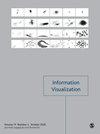MING: An interpretative support method for visual exploration of multidimensional data
IF 1.8
4区 计算机科学
Q3 COMPUTER SCIENCE, SOFTWARE ENGINEERING
引用次数: 3
Abstract
Dimensionality reduction enables analysts to perform visual exploration of multidimensional data with a low-dimensional map retaining as much as possible of the original data structure. The interpretation of such a map relies on the hypothesis of preservation of neighborhood relations. Namely, distances in the map are assumed to reflect faithfully dissimilarities in the data space, as measured with a domain-related metric. Yet, in most cases, this hypothesis is undermined by distortions of those relations by the mapping process, which need to be accounted for during map interpretation. In this paper, we describe an interpretative support method called Map Interpretation using Neighborhood Graphs (MING) displaying individual neighborhood relations on the map, as edges of nearest neighbors graphs. The level of distortion of those relations is shown through coloring of the edges. This allows analysts to assess the reliability of similarity relations inferred from the map, while hinting at the original structure of data by showing the missing relations. Moreover, MING provides a local interpretation for classical map quality indicators, since the quantitative measure of distortions is based on those indicators. Overall, the proposed method alleviates the mapping-induced bias in interpretation while constantly reminding users that the map is not the data.MING:一种用于多维数据可视化探索的解释性支持方法
降维使分析人员能够使用尽可能多地保留原始数据结构的低维地图对多维数据进行可视化探索。这种地图的解释依赖于邻里关系保持的假设。也就是说,假设地图中的距离忠实地反映了数据空间中的差异,用与域相关的度量来测量。然而,在大多数情况下,由于制图过程对这些关系的扭曲,这一假设被破坏了,这需要在地图解释期间加以考虑。本文描述了一种使用邻域图(MING)在地图上显示单个邻域关系作为最近邻图的边的解释支持方法。这些关系的扭曲程度通过边缘的着色来显示。这使得分析人员可以评估从地图中推断出的相似关系的可靠性,同时通过显示缺失的关系来暗示数据的原始结构。此外,MING提供了经典地图质量指标的局部解释,因为扭曲的定量测量是基于这些指标。总的来说,本文提出的方法在不断提醒用户地图不是数据的同时,减轻了地图在解释中引起的偏见。
本文章由计算机程序翻译,如有差异,请以英文原文为准。
求助全文
约1分钟内获得全文
求助全文
来源期刊

Information Visualization
COMPUTER SCIENCE, SOFTWARE ENGINEERING-
CiteScore
5.40
自引率
0.00%
发文量
16
审稿时长
>12 weeks
期刊介绍:
Information Visualization is essential reading for researchers and practitioners of information visualization and is of interest to computer scientists and data analysts working on related specialisms. This journal is an international, peer-reviewed journal publishing articles on fundamental research and applications of information visualization. The journal acts as a dedicated forum for the theories, methodologies, techniques and evaluations of information visualization and its applications.
The journal is a core vehicle for developing a generic research agenda for the field by identifying and developing the unique and significant aspects of information visualization. Emphasis is placed on interdisciplinary material and on the close connection between theory and practice.
This journal is a member of the Committee on Publication Ethics (COPE).
 求助内容:
求助内容: 应助结果提醒方式:
应助结果提醒方式:


